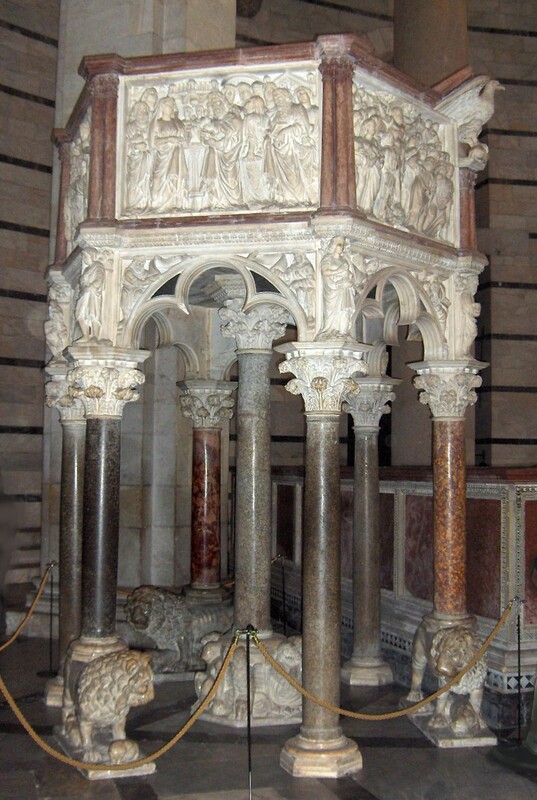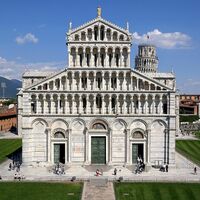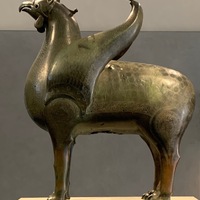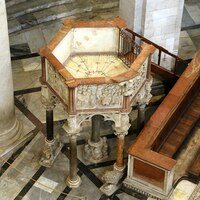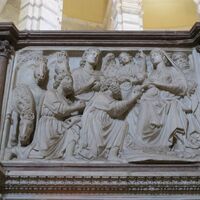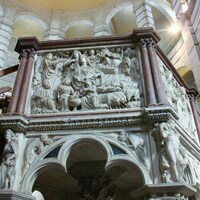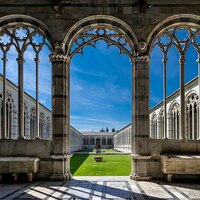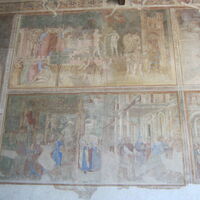Pisa's religious center
Type:
Baptisteries,
Cemeteries,
Churches,
Cities,
City walls,
Minbars and pulpits,
Sculptures,
Wall paintings,
Bronze
Date:
1064–1118 (Cathedral begun and dedicated),
1152–85 (Baptistery begun),
1174 (bell tower begun),
1277 (Campo Santo cemetery begun)
Location or Findspot (Modern-Day Country):
Italy
Description:
The Pisan navy developed in the ninth century in response to attacks by Vikings and by North African pirates. By the eleventh century the city was expanding its presence in the western Mediterranean, sacking cities under Islamic rule,, helping to take Jerusalem in the First Crusade (and establishing colonies nearby), and coming into conflict with other Italian maritime powers, especially Genoa and Venice. Pisa remained preeminent until it was defeated by the Genoese fleet in 1284.
Booty obtained from its naval successes helped fund a grand religious complex in Pisa. The cathedral (Italian Duomo) founded in 1064 and dedicated in 1118 was largely the work of two architects, Buschetus and Rainaldus. It incorporates spolia inside and out, including a large bronze griffin once displayed on the roof. In the late twelfth century the cathedral received two sets of monumental bronze doors cast by Bonannus of Pisa (only the right transept doors are preserved). Other famous artists embellished the interior, including a pulpit carved by Giovanni Pisano ca. 1310. Numerous Latin inscriptions praise artists and attest to civic pride, especially naval successes.
The Pisa Baptistery, the largest in Italy (55 m high) was begun in 1152 by the architect Diotisalvus, who worked on it until 1185. The domed, freestanding structure evokes such early Christian predecessors as the Neonian and Arian baptisteries in Ravenna as well as the Anastasis Rotunda of the Holy Sepulcher (for Christians, baptism represented rebirth in Christ). The building's double dome contributes to its excellent acoustics. The revival of public baptisms at Easter affirmed a collective Pisan identity and a sense that the republic was sanctified by Christ. Inside the baptistery, the octagonal font dates to the mid-thirteenth century. The large hexagonal pulpit was sculpted around 1260 by by Nicola Pisano, Giovanni's father; Nicola worked previously for Emperor Frederick II and campe to Pisa after the dissolution of the imperial workshiops in southern Italy. The pulpit is carved with Christological scenes and classical-looking figures inspired by ancient works, including sarcophagi, available nearby; notably, the personification of Christian Fortitude is a muscular, nude male based on a Roman image of Hercules.
The famous "leaning tower" (58 m tall), begun in 1174, held the cathedral's bells, which marked civic and religious time. It was begun by one Guglielmus and the sculptor Bonannus, who misjudged the solidity of the foundations. The building was already leaning before it was completed.
The last component of the Pisa complex is the cemetery, the Campo Santo (holy field) that contained earth from the Holy Land, reputedly brought on 53 galleys during the crusades—a century before the building was begun in 1277. Graves in the area were moved here, and from the fourteenth to the mid-fifteenth century, the inner walls were frescoed with large scenes of death and judgment by Francesco Traini, Bonimaco Buffalmacco, and other artists. During the Second World War, Pisa was bombed and a fire broke out in the Campo Santo. The frescoes that were not destroyed in the fire were detached from the walls to preserve them, a process that revealed preparatory drawings made on another layer of plaster. These drawings, called sinopias for their red pigment, sinoper, provide rare evidence of the working methods of the late Middle Ages.
Most of the materials for this ambitious project were quarried nearby, including the yellowish sandstone used for the twelfth-century city walls. The white marble and black limestone came mostly from Italy, but imported marble, probably spolia, was used at such significant locations as the base of the cathedral apse. Despite being erected over centuries, the civic complex is unified by the two-tone marble revetment of its main components and by the buildings' similar heights, repeated round arches, and blind arcades.
Booty obtained from its naval successes helped fund a grand religious complex in Pisa. The cathedral (Italian Duomo) founded in 1064 and dedicated in 1118 was largely the work of two architects, Buschetus and Rainaldus. It incorporates spolia inside and out, including a large bronze griffin once displayed on the roof. In the late twelfth century the cathedral received two sets of monumental bronze doors cast by Bonannus of Pisa (only the right transept doors are preserved). Other famous artists embellished the interior, including a pulpit carved by Giovanni Pisano ca. 1310. Numerous Latin inscriptions praise artists and attest to civic pride, especially naval successes.
The Pisa Baptistery, the largest in Italy (55 m high) was begun in 1152 by the architect Diotisalvus, who worked on it until 1185. The domed, freestanding structure evokes such early Christian predecessors as the Neonian and Arian baptisteries in Ravenna as well as the Anastasis Rotunda of the Holy Sepulcher (for Christians, baptism represented rebirth in Christ). The building's double dome contributes to its excellent acoustics. The revival of public baptisms at Easter affirmed a collective Pisan identity and a sense that the republic was sanctified by Christ. Inside the baptistery, the octagonal font dates to the mid-thirteenth century. The large hexagonal pulpit was sculpted around 1260 by by Nicola Pisano, Giovanni's father; Nicola worked previously for Emperor Frederick II and campe to Pisa after the dissolution of the imperial workshiops in southern Italy. The pulpit is carved with Christological scenes and classical-looking figures inspired by ancient works, including sarcophagi, available nearby; notably, the personification of Christian Fortitude is a muscular, nude male based on a Roman image of Hercules.
The famous "leaning tower" (58 m tall), begun in 1174, held the cathedral's bells, which marked civic and religious time. It was begun by one Guglielmus and the sculptor Bonannus, who misjudged the solidity of the foundations. The building was already leaning before it was completed.
The last component of the Pisa complex is the cemetery, the Campo Santo (holy field) that contained earth from the Holy Land, reputedly brought on 53 galleys during the crusades—a century before the building was begun in 1277. Graves in the area were moved here, and from the fourteenth to the mid-fifteenth century, the inner walls were frescoed with large scenes of death and judgment by Francesco Traini, Bonimaco Buffalmacco, and other artists. During the Second World War, Pisa was bombed and a fire broke out in the Campo Santo. The frescoes that were not destroyed in the fire were detached from the walls to preserve them, a process that revealed preparatory drawings made on another layer of plaster. These drawings, called sinopias for their red pigment, sinoper, provide rare evidence of the working methods of the late Middle Ages.
Most of the materials for this ambitious project were quarried nearby, including the yellowish sandstone used for the twelfth-century city walls. The white marble and black limestone came mostly from Italy, but imported marble, probably spolia, was used at such significant locations as the base of the cathedral apse. Despite being erected over centuries, the civic complex is unified by the two-tone marble revetment of its main components and by the buildings' similar heights, repeated round arches, and blind arcades.
Relevant Textbook Chapter(s):
7,
8,
9
Repository and Online Resources:
• Read more about the major Pisan monuments on the website of the office established to oversee them in the eleventh century.
• Learn more about Nicola Pisano's Bapistery pulpit from Khan Academy.
• Listen to a sample of the Baptistery acoustics here.
Image Credits:
Navid Jamali; Wikimedia Commons
